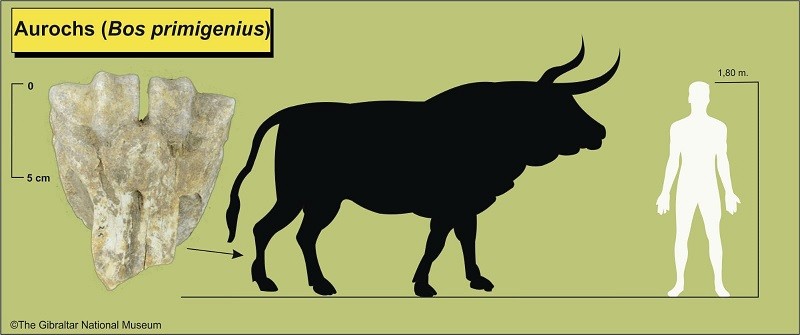A metapodial fragment belonging to an Aurochs

A metapodial fragment belonging to an Aurochs
Today we show you a metapodial fragment from the end of the leg (the bone in the ankle which links the phalanges to the limb bones) of an Aurochs. It was found in the first systematic excavations carried out in Gorham's Cave by Dr. John d'Arcy Waechter in the late 1940s and early 1950s. This fragment comes from level G, where it is associated with a Mousterian stone tool industry, so it is assigned to the Neanderthal occupation.
The remains of Aurochs are rare compared to other mammals, but they do occur in many levels of the cave sequence, including in the Upper Palaeolithic levels when the caves were occupied by Anatomically Modern Humans.
This extinct animal was a species of wild ox (Bos primigenius, an ancestor of domesticated cattle) that inhabited the Eurasian continent and North Africa. The Aurochs had a large robust body and was a very aggressive animal, strong and fast. Its habitat was characterized by forests of variable density, and herbaceous and shrub plains in areas near water.
Aurochs gradually disappeared due to hunting and domestication, the last European specimen being hunted in Poland in the early seventeenth century.
Published: June 28, 2020
Other similar Virtual Museum
Other similar VM - Paleontology
Virtual Museum VM - Historical Notes from our Archive
historical notes from our archive a. e. serfaty
Published: April 04, 2020
VM - Paleontology
palaeontology rosia bay and the beginnings of life and earth sciences
Published: April 06, 2020
Virtual Museum VM - Historical Notes from our Archive
Historical Notes from our Archive The Paint Supply Co.
Published: April 16, 2020
Virtual Museum VM - Historical Notes from our Archive
Historical Notes from our Archive The Rock Hotel
Published: April 20, 2020
18-20 Bomb House Lane
PO Box 939,
Gibraltar
